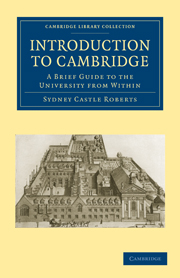II - PERAMBULATION
Published online by Cambridge University Press: 10 November 2010
Summary
The history of the university may be studied, as may be inferred from the previous chapter, in documents. It may also be studied in wood and brick and stone.
The university is older than the oldest college, but one result of the college system is that the stranger will look in vain for a building called “the University”. Until the nineteenth century, indeed, he would have found but two university buildings—the Library and the Senate-House; and the heart of the medieval university must be sought in what was, until 1934, the Catalogue Room of the old University Library and is now again known as the Regent House. This room, built over the old Divinity School at the end of the fourteenth century, served as the Chapel and Senate-House of the university; after the Reformation it was no longer used as a chapel, but remained as the centre of university legislation. The fourteenth-century roof remains, but is hidden by a richly plastered ceiling of 1600. The old Divinity School beneath it, originally built in the middle of the fourteenth century, is the oldest link with university teaching in the Middle Ages. Here lectures and disputations were held, and the schools of Canon Law, built a little later, contributed to form a “Schools” quadrangle. So the “Schools” remained until in the eighteenth and nineteenth centuries they were gradually absorbed into the University Library. Large additions were also made to the library buildings, but not large enough to keep pace with the growth in the number of books.
Information
- Type
- Chapter
- Information
- Introduction to CambridgeA Brief Guide to the University from Within, pp. 29 - 51Publisher: Cambridge University PressPrint publication year: 2009First published in: 1934
